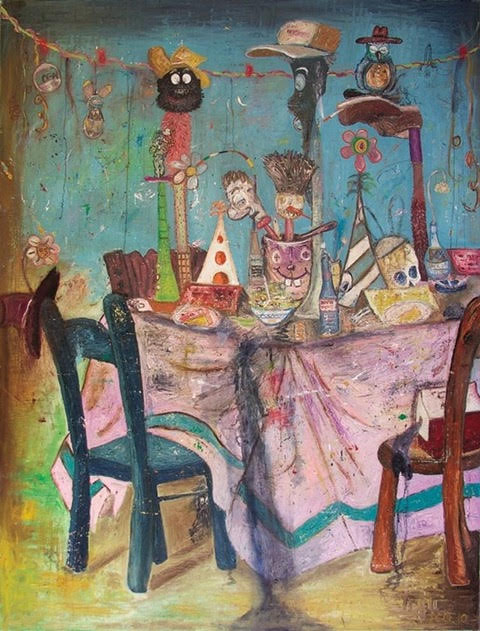Rika Nelson runs Slow Art Day and Lunch and Learn, among other programs, at the Crocker Art Museum in Sacramento and recently agreed to sit down with us and talk about her passion for art and helping the public learn how to look at and love art.
Slow Art Day: Tell us about yourself, Rika.
Rika Nelson: I am the Manager of Public Programs at the Crocker Art Museum in Sacramento, CA. It’s my job to plan and present all of our adult educational programming including concerts, lectures, films, dance, tours and more. We present an average of 8-10 Public Programs for adults each month. The programs range in size from a 10-20 person gallery program like Lunch and Learn, which we’ll talk about in a moment, to an 800 person museum-wide evening event we call Art Mix.
Slow Art Day: It sounds like a great job.
Rika: I love my job. I sometimes tell people that I feel like I hit the job lottery. We have 10 or so exhibitions per year in addition to our permanent collection and I get to work with our curators to pull out the themes and deeper meaning from each exhibition and translate it into programming that is educational, meaningful and entertaining for our visitors. I like when attendees at our programs see an exhibition from a new perspective; I also love it when our programs cause them to connect with each other.
I have wanted to work in museums since I was a kid. I studied History and American Indian Studies at the University of Washington and went on to get an MA in Museum Studies and an MBA in Non-profit Administration from John F. Kennedy University in Berkeley. I started at the Crocker three years ago right as I was finishing grad school. It was an exciting time to be working here as we were just months away from opening our new 125,000 sq. ft. Teel Family Pavilion on 10.10.2010.
Slow Art Day: Tell us about the Lunch and Learn program. How did it start?
Rika: Lunch and Learn was started through a collaboration between our museum docents and our education department. The Docents went through a VTS (visual thinking strategies) training as part of their continuing education. There were a particular group of docents who really developed a passion for this touring style and we worked with them to design a monthly tour where visitors would examine one work of art over a 30 minute period and then were invited to have lunch in the café following the program. We started with 3 or 4 visitors that would come on the tour, now we are up to about 20 or 30 per tour!
Slow Art Day: Say more – it’s monthly and has regular attendees? What is the design of the event and how does it work?
Rika: My favorite thing about the Crocker Lunch and Learn are the regular attendees we’ve started to notice. There are even a group of City Employees who come over to the Museum to spend a half hour with a work of art in our collection on their lunch breaks. The regular attendees have gotten to the point where they are familiar with each other and give encouragement to each other during the discussions.
Lunch and Learn starts with about 3-5 minutes of silent looking. We then ask the visitors in the group to talk about specific things they are seeing within the work. Next we ask people to tell us what they think the things they are seeing might mean and we ask them what they wonder. I have seen some incredible meanings pulled out of paintings by our visitors; things that never would have occurred to me. The other fascinating thing is the diverse backgrounds our visitors bring to the discussion and how that gets the whole group to have a broader understanding of the work of art we are seeing.
Slow Art Day: What do you think helps make the program work so well?
Rika: I think the program works well because it is consistent. It happens the first Tuesday of every month and people have made it a routine. I can’t think of a better routine than setting aside 30 minutes on a weekday for Art, can you?
Slow Art Day: No – we couldn’t agree more. What do you see as the relationship between your Slow Art Day event and Lunch & Learn?
Rika: I like to think that Slow Art is a way for us to introduce people to the concept so that they can join in on our ongoing Lunch and Learn series. We get a lot of visitors who hear about the Slow Art Movement and come for Slow Art at the Crocker, but they had no clue that we do a Slow Art style format every month.
Slow Art Day: The Crocker has been hosting Slow Art Day for more than four years. Can you tell us more about why the museum has been a supporter since the beginning?
Rika: I can’t take the credit for that, my predecessor at the Crocker, Christian Adame, who is now at the Phoenix Art Museum, was the early adopter. I think, however, that it is a no-brainer for us to be involved with Slow Art. All art museums should get on board. Slow Art is a way of teaching people how to look at works of art in your galleries, it gives them a tool to get more out of their visit. That kind of engagement is what keeps art museum’s relevant to their communities and that’s why we think it’s important.
Slow Art Day: We agree! Thanks for hosting Slow Art Day and for your time today and for your longtime commitment to helping more people learn how to look at and love art.

